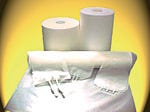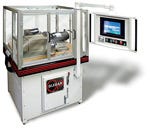September 6, 2001
Originally Published MPMN September 2001
INDUSTRY NEWS
PVC-Like Polyolefin and Flexible Guidewire Grinder Debut at MD&M East
The look, the feel of PVC
|
Applications for a polyolefin elastomer that mimics the soft, dry feel of PVC include IV, drug delivery, and blood processing and storage products. |
Although they are not being marketed as a PVC replacement, Solmed polyolefin films captured the attention of numerous visitors to MD&M East because of their potential as a substitute material. Solvay Draka Inc. (Commerce, CA; www.solvaydraka.com) introduced the polyolefin elastomer film to the North American market at the show.
"We have had a lot of interest from OEMs sourcing a non-PVC material that has the tactile qualities of vinyl," says Solvay's director of technology Robert Elcik. Other materials that exhibit properties similar to PVC do not share its soft, dry feel, he says, thus limiting their market potential in North America.
The newest additions to the Solmed family of medical-grade materials, EM-8300, EM-8400A, and EM-8600-B4 feature minimal extractables, strength, chemical resistance, clarity, flexibility, and ease of fabrication. Potential applications include IV, drug delivery, and blood processing and storage products. The material is also suited for the production of stem cell containers and nutritional, drainage, and CAPD devices.
The product's strength-to-thickness ratio permits downgauging: a 9-mil polyolefin film has the strength and durability of a 14-mil soft PVC film, according to the firm.
Heat-weldable EM-8400A withstands autoclave, gamma, and EtO sterilization; exposure to high levels of gamma radiation, however, may result in slight visual or physical property changes. EM-8600-B4 is suited for gamma and EtO sterilization and can be either heat or RF welded. EM-8300 is RF sealable and can be EtO or gamma sterilized. It has low-temperature properties.
These films can be manufactured in thicknesses ranging from 6 to 20 mil and in widths up to 34 in. Polish/matte, taffeta/matte, and matte/matte finishes are available.
Grinder promises limitless shape shifting
|
Responding to customer demands for a machine that can precisely process longer wires, Glebar has developed a guidewire grinder that can produce multiple shapes with micron-level accuracy. |
A guidewire grinding machine introduced at MD&M East can produce balls, tapers, arcs, flats, threads, barrels, teardrops, and a variety of other shapes with micron level accuracy. Exhibited by Glebar Company, Inc. (Franklin Lakes, NJ; www.glebar.com), the machine's versatility and ease of use received high marks from attendees, according to Robert Gleason, vice president– engineering.
"Our clients want longer, more precise wires . . . that can go into the brain to treat aneurysms, among other applications," says Gleason. Machining the guidewire shouldn't be akin to brain surgery, however, and Glebar designed the CAM SXE with simplicity in mind. For example, CAD files can be easily and quickly downloaded to the grinder from a floppy disk or network. "To my knowledge, this is the only commercially available machine with this amount of flexibility and accuracy," says Gleason.
"In the past, device OEMs have developed machines like this internally," adds marketing manager Mark Bannayan, "but they tend to be difficult to set up, and maintenance can be a problem. They also do not have the level of automation of our machine."
The CAM SXE features fully automated guidewire processing, including loading and unloading, and it is equipped with a NEMA 4 touch screen. Wire shape configurations can be specified manually or through a DXF file. Six-axis servomotors attain a 5-µm accuracy, and the grinding unit is set on a granite plate to ensure stability.
CAD/CAM software handles difficult surface shapes
CAD/CAM software with new surface-creation tools that can handle exceptionally difficult shapes was introduced at MD&M East by VX Corp. (Palm Bay, FL; www.vx.com). When working with complex surfaces, VX Version 5 users now can decide how much attraction or gravity to apply to a problem curve and thereby eliminate deformities.
The software features scores of enhancements, including manual and automatic healing of imported solid models; direct import capability of ProE, Catia, and Parasolid files; complex unified filleting via a single command, and lofting. On-the-fly access to the Cadenas parts library, which now supports VX-editable parts, and a new Windows-standard interface are also part of the package. Access to the Cadenas library of hardware, hardware assemblies, and mold frames enables parts to be pulled directly into VX assemblies, helping to speed product development time.
Medical applications of the software include an artificial hip joint design, according to senior applications engineer Mike Lynch.
Norbert Sparrow and Karim Marouf
You May Also Like




